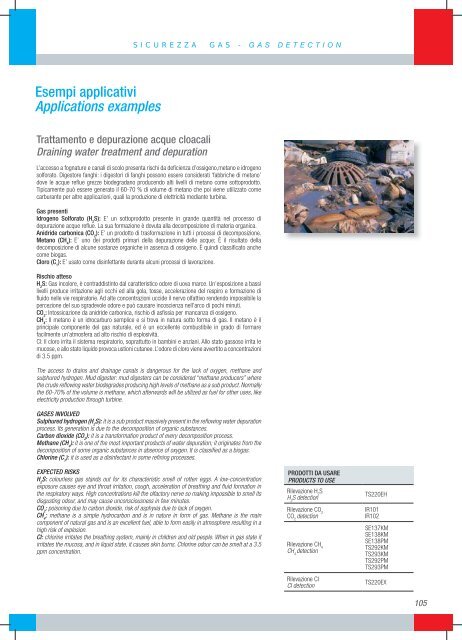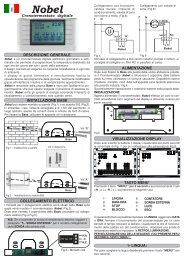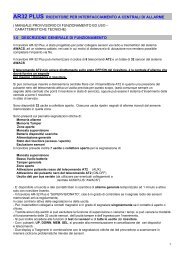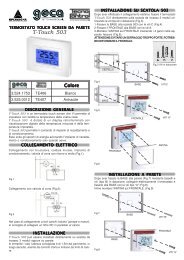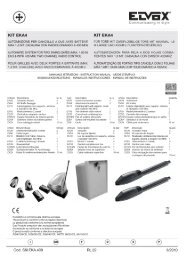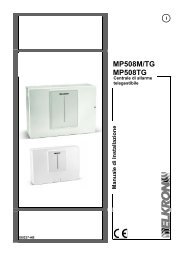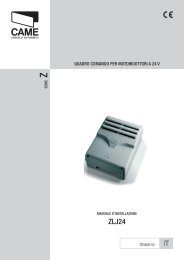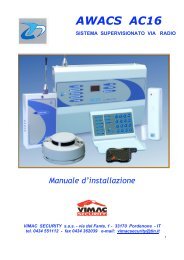Applications examples - Mgelettroforniture
Applications examples - Mgelettroforniture
Applications examples - Mgelettroforniture
You also want an ePaper? Increase the reach of your titles
YUMPU automatically turns print PDFs into web optimized ePapers that Google loves.
SICUREZZA<br />
GAS - GAS DETECTION<br />
Esempi applicativi<br />
<strong>Applications</strong> <strong>examples</strong><br />
Trattamento e depurazione acque cloacali<br />
Draining water treatment and depuration<br />
L’accesso a fognature e canali di scolo presenta rischi da deficienza d’ossigeno,metano e idrogeno<br />
solforato. Digestore fanghi: i digestori di fanghi possono essere considerati ‘fabbriche di metano’<br />
dove le acque reflue grezze biodegradano producendo alti livelli di metano come sottoprodotto.<br />
Tipicamente può essere generato il 60-70 % di volume di metano che poi viene utilizzato come<br />
carburante per altre applicazioni, quali la produzione di elettricità mediante turbina.<br />
Gas presenti<br />
Idrogeno Solforato (H 2<br />
S): E’ un sottoprodotto presente in grande quantità nel processo di<br />
depurazione acque reflue. La sua formazione è dovuta alla decomposizione di materia organica.<br />
Anidride carbonica (CO 2<br />
): E’ un prodotto di trasformazione in tutti i processi di decomposizione.<br />
Metano (CH 4<br />
): E’ uno dei prodotti primari della depurazione delle acque; È il risultato della<br />
decomposizione di alcune sostanze organiche in assenza di ossigeno. È quindi classificato anche<br />
come biogas.<br />
Cloro (C 1<br />
): E’ usato come disinfettante durante alcuni processi di lavorazione.<br />
Rischio atteso<br />
H 2<br />
S: Gas incolore, è contraddistinto dal caratteristico odore di uova marce. Un’esposizione a bassi<br />
livelli produce irritazione agli occhi ed alla gola, tosse, accelerazione del respiro e formazione di<br />
fluido nelle vie respiratorie. Ad alte concentrazioni uccide il nervo olfattivo rendendo impossibile la<br />
percezione del suo sgradevole odore e può causare incoscienza nell’arco di pochi minuti.<br />
CO 2<br />
: Intossicazione da anidride carbonica, rischio di asfissia per mancanza di ossigeno.<br />
CH 4<br />
: Il metano è un idrocarburo semplice e si trova in natura sotto forma di gas. Il metano è il<br />
principale componente del gas naturale, ed è un eccellente combustibile in grado di formare<br />
facilmente un’atmosfera ad alto rischio di esplosività.<br />
Cl: Il cloro irrita il sistema respiratorio, soprattutto in bambini e anziani. Allo stato gassoso irrita le<br />
mucose, e allo stato liquido provoca ustioni cutanee. L’odore di cloro viene avvertito a concentrazioni<br />
di 3.5 ppm.<br />
The access to drains and drainage canals is dangerous for the lack of oxygen, methane and<br />
sulphured hydrogen. Mud digester: mud digesters can be considered “methane producers” where<br />
the crude reflowing water biodegrades producing high levels of methane as a sub product. Normally<br />
the 60-70% of the volume is methane, which afterwards will be utilized as fuel for other uses, like<br />
electricity production through turbine.<br />
GASES INVOLVED<br />
Sulphured hydrogen (H 2<br />
S): it is a sub product massively present in the reflowing water depuration<br />
process. Its generation is due to the decomposition of organic substances.<br />
Carbon dioxide (CO 2<br />
): it is a transformation product of every decomposition process.<br />
Methane (CH 4<br />
): it is one of the most important products of water depuration; it originates from the<br />
decomposition of some organic substances in absence of oxygen. It is classified as a biogas.<br />
Chlorine (C 1<br />
): it is used as a disinfectant in some refining processes.<br />
EXPECTED RISKS<br />
H 2<br />
S: colourless gas stands out for its characteristic smell of rotten eggs. A low-concentration<br />
exposure causes eye and throat irritation, cough, acceleration of breathing and fluid formation in<br />
the respiratory ways. High concentrations kill the olfactory nerve so making impossible to smell its<br />
disgusting odour, and may cause unconsciousness in few minutes.<br />
CO 2<br />
: poisoning due to carbon dioxide, risk of asphyxia due to lack of oxygen.<br />
CH 4<br />
: methane is a simple hydrocarbon and is in nature in form of gas. Methane is the main<br />
component of natural gas and is an excellent fuel, able to form easily in atmosphere resulting in a<br />
high risk of explosion.<br />
Cl: chlorine irritates the breathing system, mainly in children and old people. When in gas state it<br />
irritates the mucosa, and in liquid state, it causes skin burns. Chlorine odour can be smelt at a 3.5<br />
ppm concentration.<br />
PRODOTTI DA USARE<br />
PRODUCTS TO USE<br />
Rilevazione H 2<br />
S<br />
H 2<br />
S detection<br />
Rilevazione CO 2<br />
CO 2<br />
detection<br />
Rilevazione CH 4<br />
CH 4<br />
detection<br />
Rilevazione CI<br />
CI detection<br />
TS220EH<br />
IR101<br />
IR102<br />
SE137KM<br />
SE138KM<br />
SE138PM<br />
TS292KM<br />
TS293KM<br />
TS292PM<br />
TS293PM<br />
TS220EX<br />
105


